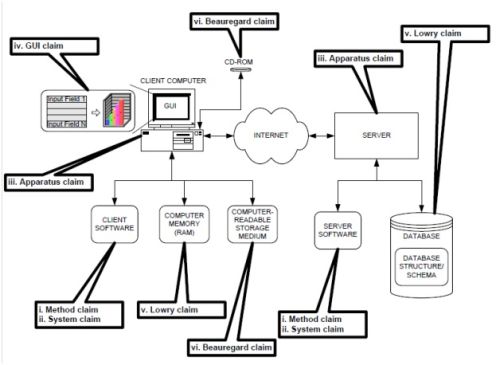On June 19, 2014, the United States Supreme Court issued its opinion in Alice Corporation Pty. Ltd. v. CLS Bank International, et al. ("Alice"). Alice's claims were directed to computerized methods, systems, and storage media (embodied with computer instructions) for mitigating settlement risk, that is, the risk that only one party to a financial agreement would satisfy its obligations. The Court struck down the claims at issue as ineligible for patenting, but nonetheless indicated that "there is no dispute" that many computer-implemented inventions are eligible for patenting.
On June 25, 2014, the U.S. Patent and Trademark Office ("PTO") issued preliminary guidance, effective immediately, for examining subject matter eligibility under 35 U.S.C. § 101 for claims involving abstract ideas in light of Alice, including claims directed to computer-implemented inventions involving abstract ideas. See "Preliminary Examination Instructions in view of the Supreme Court Decision in Alice" (available at http://www.uspto.gov/patents/announce/alice_pec_25jun2014.pdf) ("PTO's Preliminary Instructions").
The Two-Part Test for Subject Matter Eligibility—Lots of Mayo
Section 101 of the Patent Act defines the subject matter eligible for patent protection: "Whoever invents or discovers any new and useful process, machine, manufacture, or composition of matter, or any new and useful improvement thereof, may obtain a patent therefor, subject to the conditions and requirements of this title." 35 U. S. C. §101.
The PTO's threshold inquiries for subject matter eligibility under Section 101 remain the same. First, the PTO will determine whether the claim is directed to one of four statutory categories enumerated in § 101 (process, machine, manufacture, or composition of matter), and will reject the claim if it is not. Second, if the claim falls within a statutory category, the PTO will determine whether the claim is directed to a judicial exception (abstract ideas, laws of nature, or natural phenomena) and, if so, assess whether it is directed to a patent-eligible application. In this latter inquiry, the PTO will analyze the claim according to the two-part test of Mayo Collaborative Services v. Prometheus Laboratories, Inc., 566 U.S. _ (2012) ("Mayo") as follows.
Part 1: Determine whether the claim is directed to an abstract idea. PTO Preliminary Instructions at 2.
There is no prevailing definition for what constitutes an
abstract idea.1 The PTO's Preliminary Instructions
instead lists examples of abstract ideas from the case law to
provide useful guideposts:
- Fundamental economic practices (such as mitigation of settlement risk in Alice);
- Certain methods of organizing human activities (such as the hedging of risk as in Bilski—recall that the method claim in Bilski did not require computer implementation);
- An idea in itself (a principle, a motive, an original cause);
- Mathematical relationships/formulas without more (such as the formula for computing alarm limits in a catalytic conversion process in Flook, and the formula for converting binary-coded decimal numbers into pure binary form in Benson).
Part 2: If the claim includes an abstract idea, determine whether any element or combination of elements is sufficient to ensure that the claim amounts to significantly more than the abstract idea itself. In other words, are there other limitations in the claim that show a patent-eligible application of the abstract idea, e.g., more than a mere instruction to apply the abstract idea? Consider the claim as a whole by considering all claim elements, both individually and in combination. PTO Preliminary Instructions at 3.
For this step, the PTO's Preliminary Instructions list examples based on the Court's statements in Alice of what may or may not be "enough" to qualify as "significantly more" than an abstract idea:
May qualify as "significantly more" than
an abstract idea:
- Improvements to another technology or technical field (such as the mathematical formula applied in a specific rubber molding process using temperature measurements from a thermocouple in Diehr).
- Improvements in the functioning of the computer itself (same example from Diehr).
- Meaningful limitations beyond generally linking the use of an abstract idea to a particular technological environment (no specific examples given, but notes that the hardware implementation in Alice was not sufficient).
Does not qualify as "significantly more" than an abstract idea:
- Adding essentially the words "apply it" (or the like) with an abstract idea, or mere instructions to implement an abstract idea on a computer (simply implementing a mathematical principle on a physical machine such as in Alice is not sufficient).
- Requiring no more than a generic computer to perform generic computer functions that are well-understood, routine and conventional activities previously known to the industry (simply using a computer to obtain data, adjust account balances, and issue automated instructions such as in Alice is not sufficient).
Takeaways—What Does it Mean?
- The Court acknowledged that computer-implemented inventions remain eligible for patenting, and the PTO's Preliminary Instructions reflect the Court's guidance in Alice for making the eligibility inquiry.
- There is still no prevailing definition of what constitutes an abstract idea. The guidance from the Court and the PTO is articulated in terms of examples taken from cases such as Alice, Bilski, Diehr, Benson, and Flook, and the PTO's Preliminary Instructions manifest an intent to utilize such examples for guidance.
- Where general purpose computers are recited for implementation in claims, the PTO may be expected to assess whether a claim can be boiled down to a central idea (without regard to aspects of computer implementation) and then ask whether that idea was well known, routine or conventional in the industry.2 If the answer is yes, the PTO would then assess whether the claim contains an "inventive concept" in the subject matter eligibility inquiry by looking at the elements individually and in combination to assess whether the claim contains something significantly more than an abstract idea itself that transforms the claim into a patent-eligible application. See Alice, slip op. at 7.
- The second step "inventive concept" analysis may be
viewed as conflating inventiveness and subject matter eligibility.
But some may say that the inquiry is not one of applying in depth
analyses under Sections 102 and 103 to answer the question of
eligibility under Section 101. Rather, the analysis appears to
scrutinize claims to determine whether the computer implementation
is more than mere window dressing in requiring an "inventive
concept sufficient to transform the claimed abstract idea into a
patent-eligible application." See Alice,
slip op. at 11.
The PTO's guidance does not recite the "inventive concept" language, but its analysis is expected to be the same. - The second prong of the Mayo test, as applied in
Alice and as reflected in the PTO's Preliminary
Instructions, includes an instruction to analyze a claim
element-by-element, as well as in its entirety, to determine
whether the additional elements transform the nature of the claim
into patent-eligible application. Id., slip op. at 7, 11,
15.
Some may voice a concern that analysis of claim elements in isolation may make it more likely for the PTO to find a claim ineligible, because it may be easier to assert that any given claim element, particularly where carried out by a general purpose computer, is well known or conventional in the art. This analysis of elements in isolation could then cloud the analysis of the claim as a whole where none of the elements examined in isolation were determined to transform the claim into a patent eligible application. - Preemption remains an overarching concern of Section 101 jurisprudence under Alice, particularly for computer-implemented inventions. The Court in Alice reiterated that a wholly generic computer implementation of an abstract idea does not impart patent eligibility because to do so would permit monopolizing the abstract idea itself. Id., slip op. at 13. The PTO's Preliminary Instructions do not expressly discuss the preemption issue, and it will be interesting to observe whether the PTO's examination will invoke comments on preemption similar to the ones in the Court's decisions, such as in Alice.
- Computer-implemented claims that would otherwise recite elements of organizing human activities or elements capable of reading on mental steps, if the computer implementation aspects were ignored, may be particularly vulnerable to Section 101 scrutiny under the PTO's Preliminary Instructions in light of Alice.
Practical Considerations for Claim Drafting
Computer-implemented inventions can be claimed in numerous ways. For example, in a client-server setting, inventions can be claimed using system claims, method claims, Beauregard claims (i.e., claims directed to computer readable storage media for implementing computerized methods), Lowry claims (claims directed to data structures) and GUI claims (claims directed to graphical user interfaces). Examples of where these claims are applicable are shown in the following diagram.

Given the scrutiny on subject matter eligibility in the courts, it may be beneficial to consider a multitude of claiming opportunities when drafting a patent application.
Though not intended to reflect a comprehensive strategy in view of Section 101 jurisprudence, the following practical considerations (not all of which are reflected in the Alice decision or the PTO Preliminary Instructions) may be beneficial in claim drafting for computer-implemented inventions.
- Draft method claims that would satisfy the "machine or transformation test" (MoT test) where appropriate. These are claims that are tied to a particular machine or that transform an article (which could be data) into a different state or thing. As an example, instead of drafting "receiving a communication ..." consider "receiving a communication from a radio transmitter ...."
- Draft claims that do not easily read on mental steps. As an example, instead of drafting "receiving information ..." consider "receiving a data signal ...." As another example, instead of drafting "storing information in a memory ..." consider "storing a data structure in a computer memory ..." or "updating a data structure comprising a database ...."
- Draft claims in such a way that reflects the integration of the computer with the steps of the approach (e.g., calculating a particular final or interim result) and that goes beyond possible insignificant pre-solution activity (e.g., data gathering) or post-solution activity (e.g., printing, displaying).
- Utilize Lowry claims, i.e., claims directed to a data structure, where appropriate. As an example, consider "A database system comprising a first data structure ... and a second data structure ...." Also, the Lowry data structure aspect can be included in limitations of method, system and Beauregard claims to enhance the eligibility of those claims.
- Utilize GUI claims, i.e., claims directed to graphical user interfaces, where appropriate. As an example, consider "A graphical user interface for ..., comprising: a plurality of graphical interface pages arranged in a hierarchical format ...." Also, the GUI aspect can be included in limitations of method, system and Beauregard claims to enhance the eligibility of those claims.
- Draft claims that do not appear overly preemptive in scope. While limiting a claim to a certain field of use may not in itself impart subject matter eligibility, combining a field of use limitation with other strategies noted above may enhance the eligibility of a claim.
- Consider avoiding lengthy preambles that may give an impression that the claim is directed to a fundamental concept about economics or human activity. As an example, the preamble language in Alice of claim 33 recited, "A method of exchanging obligations as between parties, each party holding a credit record and a debit record with an exchange institution, the credit records for exchange of predetermined obligations, the method comprising ...." Such language might create an initial impression that a claim is directed to an ineligible fundamental economic process.
- Highlight the practical application of the claim. This could be done in the preamble and/or the end of the claim, as well as in the specification.
- After drafting a claim that recites steps implemented by a general purpose computer, assess the claim by temporarily removing the computer implementation aspects and ask whether what remains could be boiled down to a central concept that might be considered exceedingly well known in the art. If so, consider beefing up the claim, e.g., as discussed above.
- Consider using means-plus-function claims in addition to method claims, system claims, etc. Although a significant number of means-plus-function claims have been susceptible to attacks as indefinite under Section 112(b) for failing to recite sufficient structure in the specification corresponding to the claimed functions, such claims can invoke additional structure from the specification to assist in a Section 101 challenge. Of course, the specification would need to contain sufficient description of underlying structure, e.g., algorithms, for implementing the claimed functions.
In conclusion, the computer industry has changed enormously over the past several decades. This change has not only included incredible technological advancements but also affected how the computer industry has decided to legally protect its core assets. Numerous software companies, especially start-up companies, have secured software and business method patents and rely upon them as significant assets for enforcement, licensing, financing, and other purposes. These companies and their patent attorneys will be studying Alice and the PTO's Preliminary Instructions to understand how they should prepare and prosecute such applications in the future.
Footnotes
[1] The Court itself did not provide such a definition and declined to do so again in Alice. See Alice, slip op. at 10 ("[W]e need not labor to delimit the precise contours of the 'abstract ideas' category in this case.")
[2] See, e.g., Id. at 9 ("On their face, the claims before us are drawn to the concept of intermediated settlement, i.e., the use of a third party to mitigate settlement risk. Like the risk hedging in Bilski, the concept of intermediated settlement is 'a fundamental economic practice long prevalent in our system of commerce.'")
The content of this article is intended to provide a general guide to the subject matter. Specialist advice should be sought about your specific circumstances.


